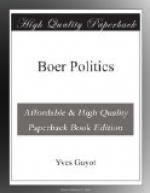This little gem merits careful analysis. Mr. Kuyper shares the belief that one has only to go to Johannesburg to shovel in the gold. If the working of mines were so simple a matter, Boer intelligence would be equal to the undertaking. As they are not worked by them, it must be because there are difficulties. These difficulties have been overcome for them by the Uitlanders. Once overcome, the Boers present themselves and say: “That gold is mine!”
“Why then did you not take it yourselves?”
The Boers, who pride themselves upon driving their teams of oxen, but who consider that to in-span them is work only fit for Kaffirs, consider gold mining beneath them, let alone that they have not the capacity for it. They leave it to the Uitlanders: all the same, Dr. Kuyper holds it just that it is they who should take the profit.
[Footnote 12: Le Siecle, 3rd April, 1900.]
2.—The Proportion of Gold per Ton.
Gold ore is found in infinitesimal quantities in large deposits of waste matter. In 1898 of the 77 Gold Mining Companies at work, three-fourths reported a yield of 1/2 oz. per ton; some only 6 to 7 dwts. per ton. Consequently we find mines worked where one ton of rock will yield 1/2 oz. of ore, or perhaps only half as much. There are other mines which swallow up the capital, and give no return at all.
3.—Cost of Production.
In 1892 gold producing in the Transvaal cost 35s. 6d. per ton; in 1897 the cost was reduced to 28s. 6d.; in 1898 to 27s. 6d. This reduction of cost is in no way due to any reforms made by the Government, but to improvements in the methods employed, and especially to the more extensive use of compressed air drills.
Out of 8,965,960 tons of ore raised in the Witwatersrand nearly 18.2 per cent. had to be thrown out; that is: about 1,634,500 tons of ore were rejected as sterile. In some cases the proportion of sterile ore has amounted to as much as 40 per cent. The cost of production from the deep levels is 34s. 6d. Out of the profits of each month, expenses and the cost of working material have to be met. (Speech of Mr. Rouliot, President of The Chamber of Mines, January 26th, 1899.)[13]
Mr. J.H. Curle in his valuable work The Gold Mines of the World, published in 1899, estimated the debts of the Rand Companies at L5,515,000. “It is not unusual,” he writes, “for the directors of a deep level mine to spend L500,000 before one single ton has been crushed.”
[Footnote 13: See the Revue Sud-Africaine (Paris), February 26th, 1899.]
4.—A Gold Mine is an Industrial Undertaking.
According to the report of the Industrial Commission appointed to inquire into the mining industry, there were, in 1896, 183 gold mines in the Transvaal. Of these 79 had been gold-producing, while 104, still in process of development, had as yet produced nothing. Of the 183 only 25 had paid dividends.




